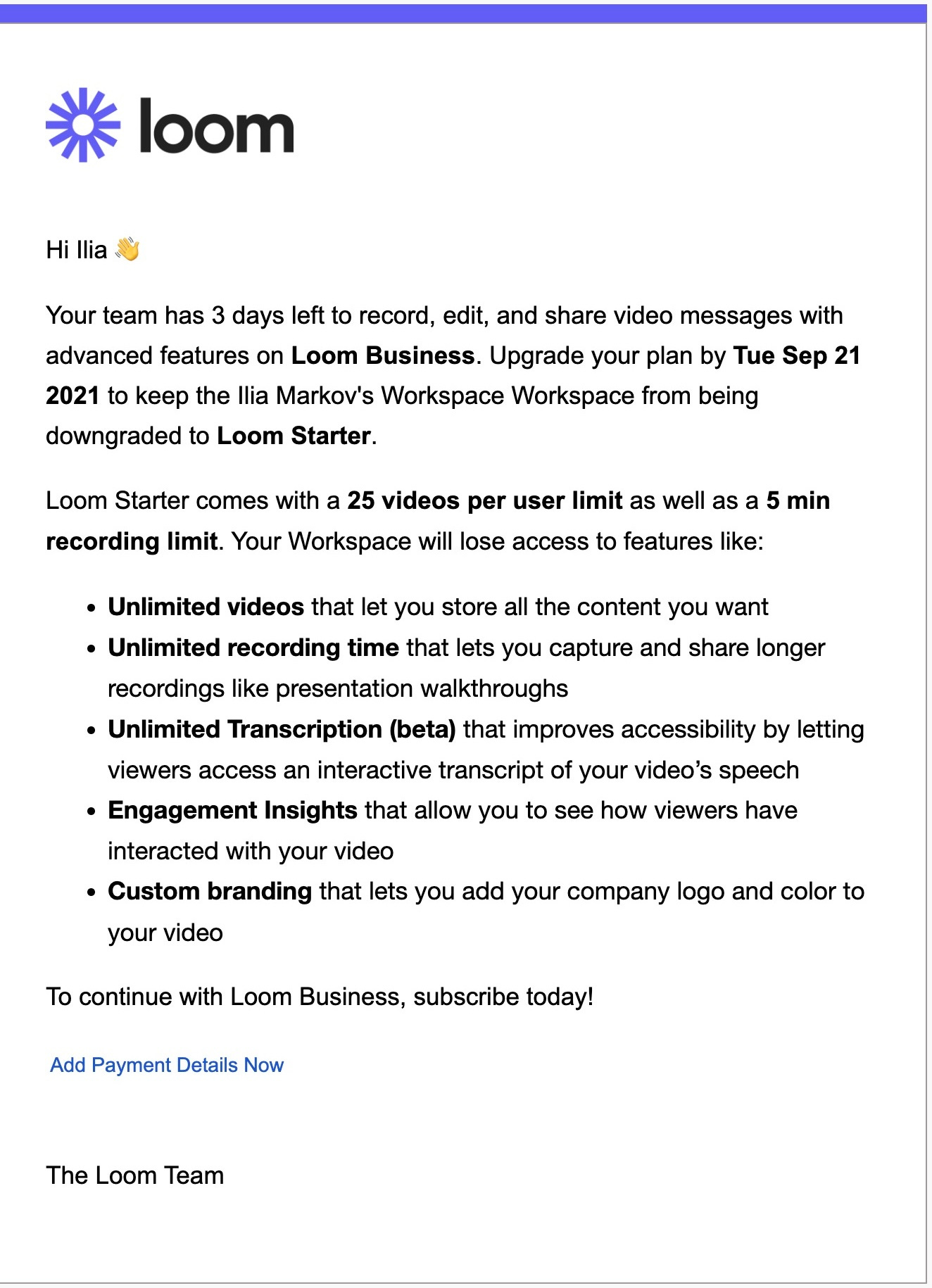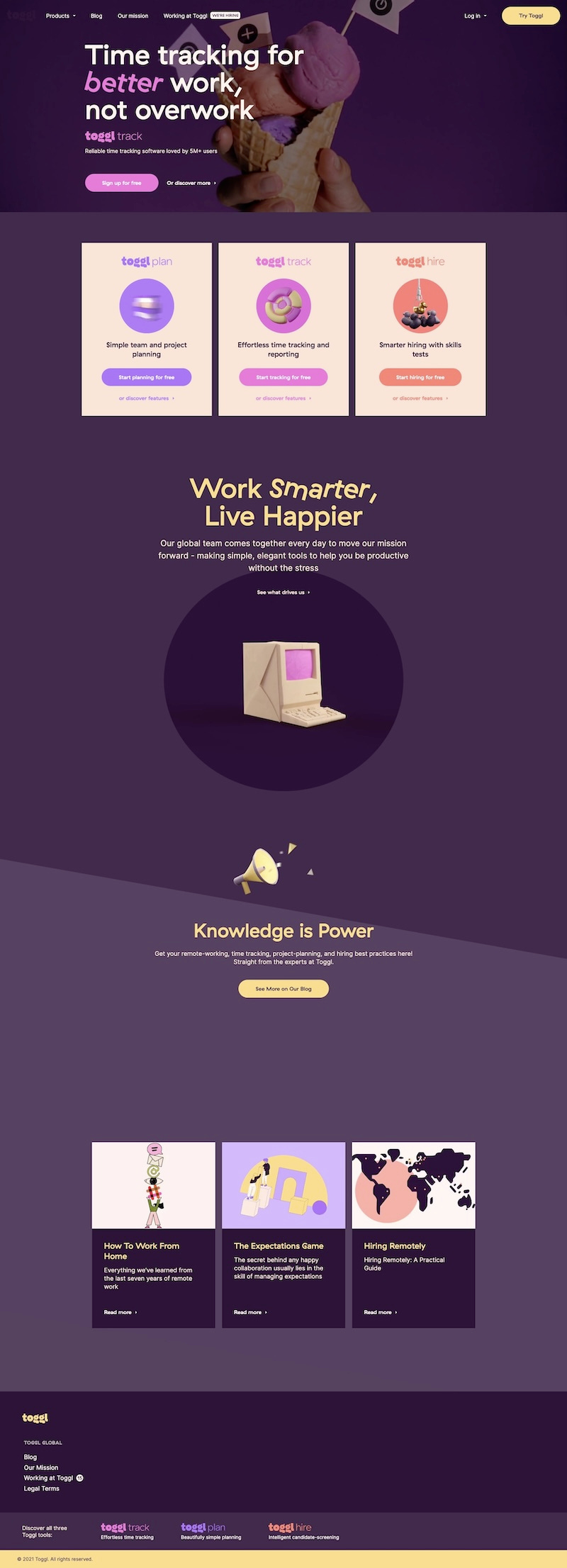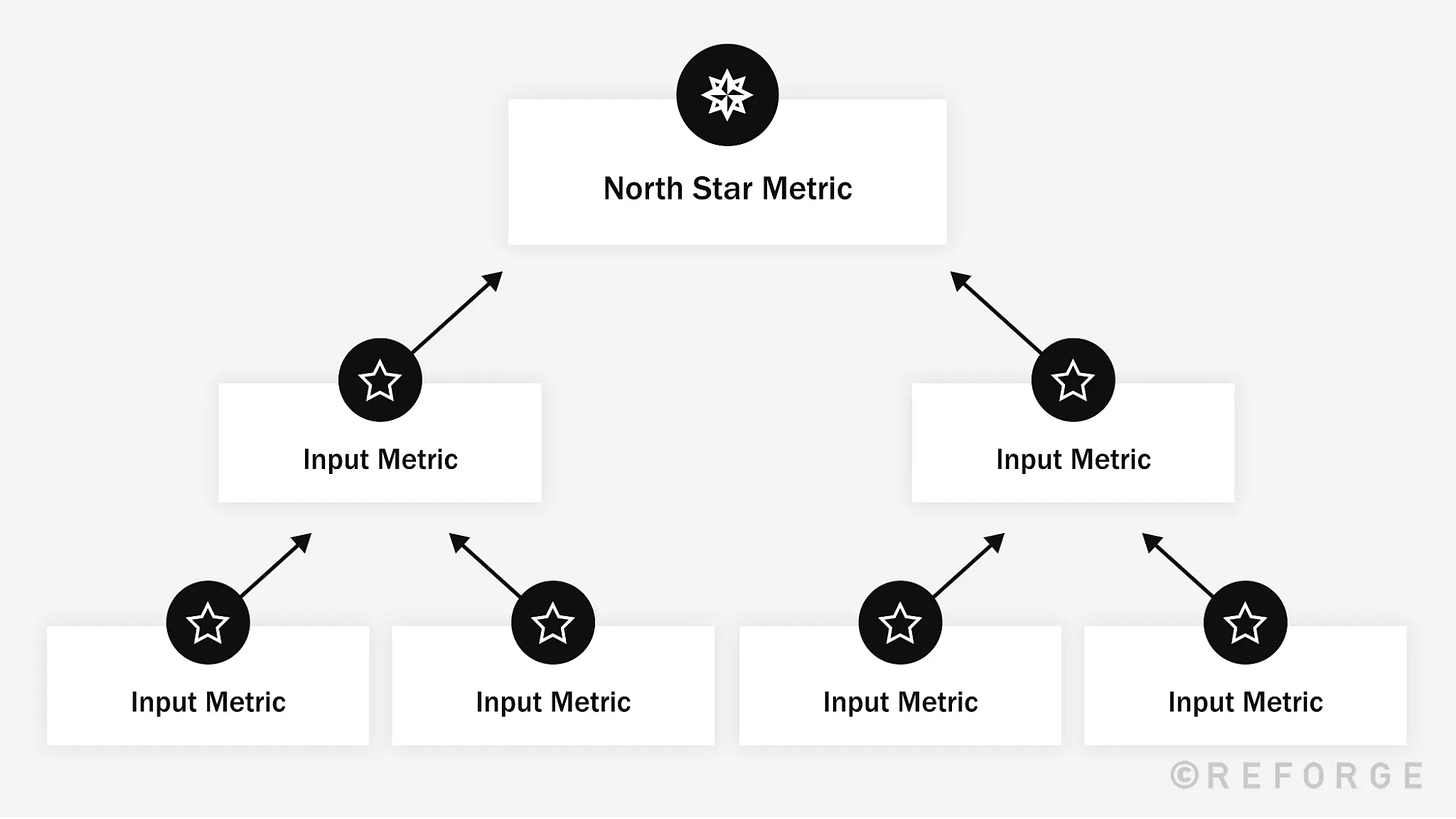Product-Led Growth: How to add or optimize your PLG motion so it actually grows your business
A case study in how we 5x'ed Toggl’s growth rate in 12 months
Hi, this is Ilia! In this newsletter, I write about growth and marketing for SaaS companies. Thank you for reading this and if you like it, feel free to subscribe and share with anyone who might find it useful.
So much digital ink has been spilled on the topic of Product-led growth, that you’d think by now everyone who’s ever wanted to use it has done so.
Of course, that’s not true – many SaaS companies are still struggling to find the best path to benefit from PLG in a way that helps the business grow (rather than just add a bunch of free users who never do anything).
So I thought, it’d be interesting to share how we approached this exact challenge/goal for Toggl Track when I was leading the marketing team.
If you’re not familiar with the company, Toggl is a multi-product company, best known for it’s time tracking tool Track, which is one of the oldest and best known products in the category.
Toggl was practicing PLG before it even had a name, but when I joined Toggl in May 2021, the company was looking for a way to reignite growth both with self-serve and by adding a sales-driven motion (which needed to be fed).
Finding a way to use product-led growth to achieve both was my mandate as a newly minted marketing leader.
This is the story of how the team 5x’ed growth.*
(*Naturally, achieving this feat was thanks to many people across Revenue and Toggl as a whole.)
What is PLG?
Let’s start with a definition. I did what every sensible person would do and asked ChatGPT for one:
Product-led growth (PLG) is a business strategy where the product itself serves as the primary driver for acquiring, retaining, and expanding customer base. In a PLG model, the product is designed to deliver significant value to users from the very first interaction, encouraging organic growth through user satisfaction, word-of-mouth, and self-service. This approach leverages the product's usability, features, and overall experience to fuel growth rather than relying heavily on traditional sales and marketing efforts.
But to me, the most important aspect to understand about PLG is the growth part in it – PLG is about finding ways to grow your business by organizing your product and UX in a way that automates attracting, converting, and monetizing users.
The essential elements of PLG
All this is great, but what does it mean to have a PLG motion?
Broadly, there are 2 dimensions to the answer – one related to your product and one focused on marketing.
In this article, I’ll only focus on the latter one.
So, when we talk about PLG in relation to marketing, these are the crucial elements you need to get right:
Clear ICP understanding (and alignment with other teams/stakeholders)
Your website
The signup flow for your product
In-app and email onboarding
Conversion prompts/pathways
Measurement and tracking
The elements are a mix of strategic and tactical:
working on the ICPs allows you to make sure that PLG makes sense for your product and you’re going after the right people
Website, signup flow, onboarding, conversion paths are all tactical elements you need to have to achieve PLG
Being able to track and measure accurately allows you to understand performance and optimize your PLG motion
To reignite Toggl’s PLG, we tackled each of these elements.
Customer Segmentation and Alignment
This was the biggest challenge and (in my opinion) the main reason why Toggl’s organic growth was stagnant.
When I joined the company, I noticed it was positioning itself as time tracking for everyone – freelancers, small companies, big companies (the website literally said that).
This was creating problems across the board – from product development to how (and where) Track was marketed and sold.
Along with our super-talented product marketer Violet Kim, we started an initiative to update create proper ICPs (ideal customer profiles) focusing on 2 elements:
Bring live to who our customers are with relevant data – type of company (going beyond the simple professional services/agencies), how big, who’s the champion within these companies looking into time tracking solutions, etc.
Uncover their challenges and pain points that prompt them to look for a solution like Track and connect those with actual features that we have that can help them solve their issues.
Website and signup flow
I joined Toggl in May 2021. In the beginning of that same year, the company went through a rebranding initiative, led by an agency specializing in similar projects.
The motivation to engage in the rebranding exercise was that Toggl had previously acquired 2 additional tools and wanted to bring all products under one brand in order to enable organic cross-selling.
The problem with giving such a project to an agency that specializes in branding is that you lose the deep SaaS thinking.
Brand agencies ultimately think in brand terms, not in “How is this change going to affect organic and technical SEO?”
So, when I joined the team I inherited a homepage that was more of a corporate “We’re a family of products” than a typical SaaS website:
Naturally, this was hurting organic conversions for Track (other products had no benchmark to compare against) as it was adding an extra step where you had to go from the homepage, to the product page (toggl.com/track) and sign up from there.
(The /track pages has been removed but you can see what it looked like using the Wayback Machine.)
However, a quick analysis showed that most of the signups for the other two products (Plan and Hire) were coming from Track customers – therefore, we were making the point that it’d be better for the other products as well if we re-focussed the global homepage to promote the main product Toggl was best known for.
After we got approval to make the change, we gradually started transitioning the homepage to the new (old) vision.
On top of the multi-product approach, it was also using a bunch of odd visuals – an animation in the hero section (which was causing page load issues), too much white space, no clear persona/value proposition, etc.
I’m not going to go through all the iterations, but want to point out some of the changes we made.
Clear focus for the hero section
The visible area (often called “hero” or “above the fold”) is the 5th Avenue flagship store for any SaaS brand. You should spend more time on it than any other part of your website (possibly all other parts taken together).
Our goal for it was two-fold:
Explain what the value of Track is
Show how easy it is to use the product
One of the main value points of Track that we constantly heard from our customers (especially the end users) is how damn easy it is to track time with it.
So we really wanted to hammer this point home.
To this effect, we decided to add a visual representation of how easy it is to start tracking time with an animated timer that started tracking time as soon as someone landed on the homepage.
(Unfortunately the animation has been lost – even to the Wayback Machine.)
At one point, we were even looking into adding an interactive element to the hero where people can start a timer and then sign up for the product, continuing to see the same timer entry when they land in the product to start onboarding.
Effectively, starting product onboarding before they even sign up.
The website went through many iterations (not an overstatement) and while it would never look 100% boilerplate SaaS website (we still had to give at least a passing mention to the other two products), over time it became a lot more recognizable (i.e. you would know it’s a SaaS if you just stumbled upon it):
However, no matter how great your website looks, it’s only the first step in a holistic process – of opening an account and using the product for the first time. And because PLG relies on allowing people to discover the product on their own, figuring out the whole process is critical.
Get users started as fast as possible
The goal for our signup process had always been to get users into the product and using the app as soon as possible.
To that end, Track’s signup form has always been very minimalist – just an email field.
While we kept this, we saw that it was creating its own set of challenges. Because we also lacked any form of onboarding survey – to collect demo/firmographic data about new users – we knew very little about our audience, so had challenges knowing how to target them better or even what to tell them during their trial.
In addition, while a frictionless signup process is great for PLG, it tends to create large numbers of unengaged users. For Toggl this was manifesting as a large number of new users who would not come back to the product past their initial session (when they signed up).
Which brings us to the next big element of PLG.
A note on Reverse Trials
I’ve written about Reverse Trials in the past, so just a quick note:
A reverse trial is the practice of putting every free signup on a free trial giving them access to all premium features your product has to offer.
Toggl had switched to a reverse trial model before I joined and it was performing better than any of the alternatives in terms of generating paying accounts.
In-app and email onboarding
The fewer barriers you have to creating an account, the more unengaged users you’ll get in your product.
You might think this is ok – These people were never going to be serious about using anyways – but the reality is that people are busy and few signup for products when they don’t think they might be useful.
For an excellent overview of how to get a PLG onboarding right, check out this post by Kyle Poyar on LinkedIn.
It is critical that you have a carefully devised plan to engage new users with the goal of showing them how they can derive value from using your product.
When I joined Toggl, Track had a few in-app messages and a single welcome email with little information about how to get started or what the app can help you with.

Over time, we added an onboarding flow focussed on educating users on the features that can empower them to be better professionals.
In addition, because everyone starts on a free trial and has access to the full set of features during the first month of using Track, we wanted to get people to use the premium features.
We’re talking things like billable rates and advanced reporting functionality:

Our analysis of product usage has shown (unsurprisingly) that the accounts who use these premium features are more likely to convert to a paid plan.
Conversion pathways
A great PLG product is one with conversion to paid nailed into the product – but conversion rarely happens on its own without asking & incentivizing people to start paying.
Naturally, the first step is to explain the value and convince users that they can realize it.
But you also need to push them to convert – especially in the cases where you are utilizing the reverse trial flow and users might not even be aware they are using the premium version of the product.
There are several ways in which you can address this during trial:
Let them know when they start: As soon as they sign up, show them an in-app message and/or send them an email telling them they’re on the premium plan and for how long.

Tell them what they’re going to lose: As their trial approaches expiration, send another message making them aware of the value they’ve been getting.

Personalizing this is key – because it makes the loss feel a lot more tangible. With Track, we could say something like:
You’ve tracked X hours of Billable time. You’ve automated weekly reports for X clients.
This makes it fairly easy for the person on the receiving end of the communication to understand what losing this is going to cost them – for example a few extra hours a week to prepare and email timesheets/reports to their clients.
(Canva does this really well in their cancellation flow.)
Measurement and Tracking
These are actually 2 topics under one hood, with both being super important for getting PLG right.
I try to be very aware of ROI Myopia but if there’s one place where you have to put yourself in the hands of the data gods, it’s this one.
You can’t build a high-performing PLG program without being able to track accurately and measure your whole flow around attracting, converting, and monetizing users at scale.
How we did it at Toggl?
In full honesty, this was the part we struggled the most with. Between tracking issues, people using adblockers, migrating to GA4 and so on, it often felt like I was flying a jet liner with a blindfold on.
But thanks to a talented and dedicated data team we slowly got the basics right and started building on top.
Company-wide, we aligned on using Heap to get accurate tracking from initial visit through conversion and all the way to understanding how people used the product.
This data was then piped into Looker, where we would apply a multi-touch attribution model to try understand the combined impact of different channels.
In addition, the marketing team would also pull and layer on data from other tools we were using, for example Google Search Console and Ahrefs, in order to give us an even broader picture of progress.
As I said, all of this data was combined in Looker, so naturally we were using it as well to build dashboards for reporting.
Reporting and measurement framework
I’m a firm believer in loops > funnels, but you still need to measure the path your users/customers take in order to identify bottlenecks or spot issues before they get out of hand.
The marketing team at Toggl was broadly organized by channel with 1-2 people owning one along with a set of KPIs/performance targets.
The channels were:
Organic: responsible for content & SEO
Performance: Google Ads/Display and anything paid
Community: responsible for social & referral traffic, and partnerships/affiliate
Lifecycle: responsible for email, in-app messaging, and (broadly speaking) engaging our community of users/customers
Marketing Design/Dev: formally responsible for performance in the Direct channel, but really in charge of the marketing website
Product marketing: not directly tied to a channel/KPI, but more of a strategic partner for all other channel owners and a go-between between Marketing/other Revenue teams and Product/Engineering.
Each sub-team/channel owner would have a set of metrics to own and act on. We had two goals for each of these:
They should be under the control of the channel owner as much as possible.
They should serve as a bellwether to the business goals/KPIs marketing owned: new self-serve revenue and pipeline generated for Sales.
For example, the KPIs for the Organic channel would look something like:
Organic impressions and clicks (pulled from Search Console)
We had a list of ~30 prioritized money keywords that we were calling The Crown Jewels
Organic traffic and signups
We were keeping a close eye on organic conversion rate, because we wanted to make sure our content was attracting relevant readers (vs. changing traffic as a vanity metric)
Conversion of organic signups to customers
For example, were trials attributed to organic channel, more likely to convert to paying customers compared to the average/other channels
Conclusion: Putting it all together
I hope that, after reading this, you feel energized to go and apply some of these tactics for yourself.
Because I’m about to dampen your enthusiasm…
None of the things I described above is a silver bullet that’s going to transform your company overnight and have investors line up to throw money at you.
What you get is a baseline.
The elements I outlined above give you a foundational framework for a successful PLG.
But then it takes a lot of observation, experimentation, and humility (learned the hard way) to find the best formula for your specific business and product.
Good luck!
(And if you need some help, feel free to get in touch.)









